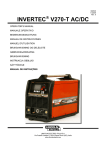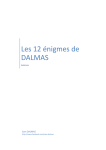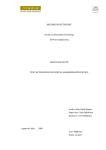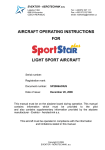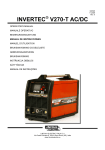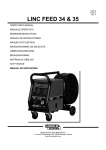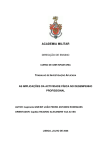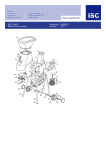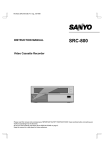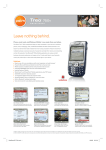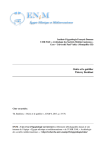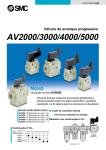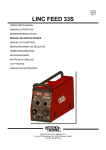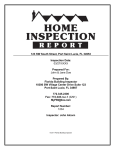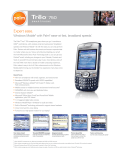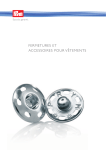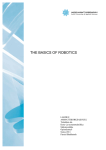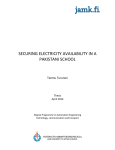Download Motor test bench designing for the Rotax 912 ULS motor
Transcript
University of Applied Sciences, Tampere Mechanical and production engineering Aeronautical engineering Tomi Mäkelä - Diomède Senou Final thesis Motor test bench designing for the Rotax 912 ULS motor Project supervisor Head of Aeronautical Studies TAMK Tampere 8/2009 Heikki Aalto University of Applied Sciences, Tampere Mechanical- and production engineering Aeronautical engineering Tomi Mäkelä Diomède Senou Motor test bench designing for the Rotax 912 ULS motor Engineering thesis 64 pages Supervisor Head of Aeronautical Studies Heikki Aalto 31.8.2009 ______________________________________________________________________ Abstract In this work was rearched differend possibilities for a test bench assembly with a Rotax 912 ULS light aircraft engine. Main goal was to find a solution with a good realisation value and a soluton that could be used as an instructions when starting to assembly a test bench. Main parts of the test bench are the tested engine, the engine brake and the measuring instruments. Most important part is the engine brake which gives a load for the tested engine and this way simulates the real use of the engine. Options for the engine brake were hydraulic-, electronic-, propeller- and water brake. Measuring instruments include also an recording device that records all the information from the test. The main measured factors are the speed (RPM), the power and the fuel consumption of the motor in a differend power areas. A good measuring accuracy gives a great value for the test bench. It is hard to achieve, but it can be achieved. The main points for the accurate measuring are knowing the equipments and training the use of the equipments, minimizing the effect of the environment and the humans to the test bench; and to make sure that the engine brake works propetly and gives the needed load. Safety comes before doing anything. There should be a safety plan for the ready made test bench to prevent injuries and damages to the school. Protecting of the users, preventing fires and making sure that there is no negative effect to the nature. All these can be prevented with a safety and environmental plan. ______________________________________________________________________ Keywords test bench, motor brake, power, fuel consumption, price estimation Tampereen ammattikorkeakoulu Kone- ja tuotantotekniikka Lentokone tekniikka Tomi Mäkelä Diomède Senou Rotax 912 ULS testipenkin suunnittelu Opinnäytetyö 64 sivua Työn ohjaaja Yliopettaja Heikki Aalto 31.8.2009 ______________________________________________________________________ Tiivistelmä Tässä työssä on tutkittu mahdollisia vaihtoehtoja testipenkille, joka on suunniteltu toteutettavaksi Rotax 912 ULS lentokone moottorin kanssa. Tavoitteena oli löytää toteutus kelpoinen ja koululle hyödyllinen kokoonpano, joka toimisi ohjeena testipenkkiä toteutettaessa. Testipenkki voidaan jakaa kolmeen osa-alueeseen, testattava moottori, moottori jarru ja mittaus sekä tallennus välineet. Tärkein osa on moottori jarru, se kuormittaa testin aikana testattavaa moottoria ja siten simuloi oikeaa käyttö tilannetta. Vaihtoehtoina oli hydrauli-, sähkö-, propelli- ja vesijarru. Mittaus ja tallennus välineet auttavat tarkkailemaan testin kulkua reaali ajassa sekä testin jälkeen. Tärkeimmät mittaus ja tarkastelu kohteet ovat moottorin pyörimis nopeus, moottorin teho ja polttoaineen kulutus eri teho alueilla. Mittaus tarkkuudella on suuri merkitys kun mietitään testi penkin toteutus arvoa. Ilman tarvittavaa tarkkuutta, mittaus tulokset ovat hyödyttömiä. Kouluttamalla käyttäjät tuntemaan ja käyttämään mittaus sekä testi laitteita oikein, minimoimalla ympäristön ja ihmisen vaikutusta testi penkkiin ja pitämällä varmuuden moottori jarrun oikeasta toiminnasta, saadaan mittaus tarkkuus riittävän suureksi. Turvallisuus saavutetaan tekemällä turvallisuus suunnitelma valmiille testi penkki kokoonpanolle. Se auttaa vähentämään huomattavasti loukkaantumisia, kuten erittäin mahdollisia palovammoja. Ympäristöstäkin pitää huolehtia ja estää haitallisten aineiden pääsy luontoon tekemällä myös ympäristön suojelu suunnitelma. Esimerkiksi öljyjen ja jäähdytys vesien päästö luontoon pitää estää. ______________________________________________________________________ Avainsanat testipenkki, moottorijarru, teho, polttoaineen kulutus, hinta-arvio Prologue This work was a research to find a good composition for a test bench with Rotax 912 ULS engine. The project is ment to be used in the future as a guide, how to make the test bench. It is meant that the test bench will be built after the flight hours of the present engine or after there is mounted a new engine in the university’s Eurostar airplane. I want to thank my teacher Heikki Aalto from giving this possibility to make the project for the university and my team mate french intership student Diomède Senou whit whom I made the project. Tampere 28.8.2009 Tomi Mäkelä Diomède Senou University of Applied Scienses, Tampere Final thesis Mechanical and production engineering, Aeronautical engineering Tomi Mäkelä Diomède Senou 5 (64) 1 Introduction .................................................................................................................... 7 2 Rotax .............................................................................................................................. 8 2.1 Rotax aircraft engines ............................................................................................. 8 2.2 Fuel consumption .................................................................................................... 9 2.3 Eurostar EV-97 ultra light airplane ....................................................................... 12 3 Testing.......................................................................................................................... 13 3.1 Test bench ............................................................................................................. 13 4 Engine brake ................................................................................................................ 15 4.1 Coupling of the motor and the motor brake .......................................................... 15 4.2 Hydraulic brake..................................................................................................... 18 4.3 Electric brake ........................................................................................................ 21 4.4 Fan Brake .............................................................................................................. 25 4.5 Water brake ........................................................................................................... 25 5 Cooling of the test bench ............................................................................................. 27 6 Measuring .................................................................................................................... 29 6.1 Display .................................................................................................................. 29 6.2 Fuel consumption .................................................................................................. 30 6.3 Power .................................................................................................................... 31 6.4 Speed (RPM) ......................................................................................................... 33 6.5 Torque ................................................................................................................... 34 6.6 Temperature .......................................................................................................... 35 7 Services that the University could offer....................................................................... 37 7.1 Configuration of the motor ................................................................................... 37 8 Expenses and the chosen hardware .............................................................................. 39 8.1 Instruments............................................................................................................ 39 8.2 Engine brake ......................................................................................................... 43 8.3 Coupling................................................................................................................ 45 8.4 Rest of the needed hardware ................................................................................. 45 8.5 Price estimations for different motor brakes and full kits..................................... 46 9 Error of the measured values ....................................................................................... 47 9.1 Errors in measuring ............................................................................................... 48 9.2 Interference during the measuring ........................................................................ 48 9.3 Calculation of the error ......................................................................................... 49 9.4 Errors in the test bench ......................................................................................... 51 10 The future rotax engines ............................................................................................ 54 11 Environment ............................................................................................................... 55 12 Safety ......................................................................................................................... 56 13 Conclusions ................................................................................................................ 57 References ....................................................................................................................... 59 Attached files .................................................................................................................. 61 5 University of Applied Scienses, Tampere Final thesis Mechanical and production engineering, Aeronautical engineering Tomi Mäkelä Diomède Senou 6 (64) Special symbols and meanings Rotax Austrian engine manufacturer Jabiru Australian engine manufacturer, makes engines for same class as Rotax Eabs absolute error Va approximate value VA average of all measured values VP one measured value from any point of the test ER random error VR real value Erela relative error Es systematic error ftlb (foot pound) is equivalent to 1.35 Newton meters. g/kWh If mogas density is 0.72 kg/l then 720 g is 1l. 6 University of Applied Scienses, Tampere Final thesis Mechanical and production engineering, Aeronautical engineering Tomi Mäkelä Diomède Senou 7 (64) 1 Introduction In this work are thought different possibilities how to make a motor test bench for Rotax 912ULS motor and it will be an instruction to make the test bench in the future. The motor can be found in University’s Eurostar airplane and after the motors flight hours are full it is meant to be tested in the motor test bench. Subject for this work was given to me by my teacher Heikki Aalto. My goal in making of this project is to learn to think over and to make projects like my future job as an engineer would give to me. The project is also a practice for me to use my english as a working language. The project is made as a team work with a French internship student Diomede Senou. The final solution that I want to be founded is a realistic solution to make the test bench with a reasonable amount of money. The solution should also be useful for the University to fulfill. 7 University of Applied Scienses, Tampere Final thesis Mechanical and production engineering, Aeronautical engineering Tomi Mäkelä Diomède Senou 8 (64) 2 Rotax Motor what is studied here is a Rotax 912 ULS. It is part of the Rotax 912 engine family and it is especially designed for the recreational aircraft use. It is used in University’s Eurostar EV-97 ultra light airplane, and because of that the motor test bench will be especially designed for this motor type. /3/ 2.1 Rotax aircraft engines Rotax manufactures 5 different kind of engine models for aircraft use at the moment. There is the 900 series, in which the project motor also belongs to, and the 500 series of motors. From which the 900 motors are 4-stroke and the 500 motors are 2-stroke engines. /3/ All the 900 series motors are boxer engines, which means that the four cylinders are placed horizontally opposed. As it can be seen from the picture 1 above, the cylinders are in the bottom of the motor and they are horizontally mounted. Boxer type of motor gives stability for the airplane when flying. /1/ Picture 1, Rotax 912 ULS /1/ 8 University of Applied Scienses, Tampere Final thesis Mechanical and production engineering, Aeronautical engineering Tomi Mäkelä Diomède Senou 9 (64) Below is presented the main characteristics of the Rotax 912 ULS motor. Table 1, /2/ Version Performance Torque Max RPM kW HP RPM Nm ft. lb. RPM RPM 912 ULS 69.0 95 5500 128 94 5100 5800 Max 5 min (take-off) 73.5* 100* 5800* * with Rotax airbox & exhaust system Table 2, /2/ Bore 84 mm Stroke 3.31 in. 61 mm 2.4 in. Displacement Compression Ratio 1352 cm3 10.5:1 82.6 cu. in. To help the comparasion of the fuel consumption to the Jabiru 2200 engine, in table 3 is presented the main charasteristics of the Jabiru engine. Table 3, /20/ Version Jabiru 2200 Performance Max RPM Torque kW HP RPM Nm ft. lb. RPM RPM 64.0 85 3300 200 148 2500 3300 2.2 Fuel consumption Rotax 912 ULS is more fuel efficient than other similarly sized engines. In addition to the lower fuel consumption they are certified to run with automotive fuel (Mogas) further, reducing running costs. The engines are very popular in Europe due to the lower fuel consumption and lower noise generated. /3/ 9 University of Applied Scienses, Tampere Final thesis Mechanical and production engineering, Aeronautical engineering Tomi Mäkelä Diomède Senou 10 (64) The fuel consumption of the motor is presented below, with percentage use of the maximum power in common flight situations. During the regular flying 65%, during the landing 75% and during the takeoff 100%. Where the * is maximum take off power. Table 4. /2/ 912 ULS Power setting (%) RPM 65 4800 75 5000 100* 5800 44.6 59.8 51.0 68.4 73.5 100.0 88.7 65.4 97.4 71.8 121.0 89.2 18.0 4.8 4.0 20.0 5.3 4.4 27.0 7.1 5.9 Power KW HP Torque NM Ft Lb Fuel Consumption Liters/Hr U.S. Gal/Hr Imp. Gal/Hr In table 5 is presented a spesific fuel consumption of the Rotax 912 ULS engine compared to the engine speed (rpm). Table 5, /5/ 10 University of Applied Scienses, Tampere Final thesis Mechanical and production engineering, Aeronautical engineering Tomi Mäkelä Diomède Senou 11 (64) In table 6, below, is presented the fuel consumption of the Jabiru 2200 engine with percentage use of the power. It uses the same fuel as the Rotax engine, mogas. Table 6, /19/ Jabiru 2200 Power setting (%) Fuel Consumption (Litres/Hr) 75 100 15 21 In table 7 is presented a specific fuel consumption for a mainstream 1600 cc combustion engine. The table is measured in test bench and the motor is a regular passenger car motor. The fuel consumption is compared with the engine speed and the torque. The numbers on the table measure the amount of fuel that is used in g/kWh. For example, if mogas density is 720 g/l then 270 g/kWh is 2.66 l/h. Table 7, /18/ 11 University of Applied Scienses, Tampere Final thesis Mechanical and production engineering, Aeronautical engineering Tomi Mäkelä Diomède Senou 12 (64) 2.3 Eurostar EV-97 ultra light airplane The Evektor EV-97 Team Eurostar, picture 2, is an ultralight aircraft designed for sport/leisure flying, touring and training with limitation to non-aerobatic VFR operations. The Eurostar is aerodynamically controlled, single-engine, two-seat, low-wing, all metal plane with a fixed tricycle undercarriage and controllable nose wheel. The aircraft is equipped with four cylinder four stroke 80 HP Rotax 912 UL engine, optionally 100 HP Rotax 912 ULS or 80 HP Jabiru 2200. Excellent flight features, reliability, outstanding design and high performance - these are synonyms for Team Eurostar - one of the most popular ultralight aircraft today, according to the Evektor webpage’s. Today already around 400 Eurostars are flying in more than 40 countries all around the world. This aircraft is called Sportstar in US and Eurostar in Europe. /15/ Picture 2, /26/ 12 University of Applied Scienses, Tampere Final thesis Mechanical and production engineering, Aeronautical engineering Tomi Mäkelä Diomède Senou 13 (64) 3 Testing The development of all kind of motors to what they are now is a result from a lot of testing. When the motors have developed, also the testing systems have developed much. Nowadays the testing is developing very fast because the fast growing demands of the customers, the manufacturers and the legislators. /6/ What we are most interested in is the combustion engine testing. So we try to look for different testing methods mainly from the automotive industry where the combustion engines are playing a big part. Nowadays the engine testing in automotive industriy is done by test benches, where the motor is placed in the test bench not in the car. Before it was done by driving on the road and after on the roller test bench, testing the motor by placing the traction wheels on the roller and it was droved when staying still. When testing the motor in the test bench, the engine can be tested and calibrated already before mounting it in the car. The test bench is often controlled by computer, which records the measuring info and can simulate different kind of driving situations. /24/ 3.1 Test bench The main challenge of test bench control is to achieve a good tracking performance (accuracy), even if the test bench system, especially the combustion engine test bench behavior, is not well known. Test bench considers three main elements the motor brake, the measuring system and the engine that is tested. /24/ The motor brake simulates the drag what motor in real use gets from for example tires in car etc. Motor brake is connected via driveshaft to the motor and that way it loads the motor as much as it is meant to. The measuring system collects the information from the motor when it is running and brings the information for the operators use. When the measuring system is equipped with a computer, the computer records the testing info and it can be viewed later. 13 University of Applied Scienses, Tampere Final thesis Mechanical and production engineering, Aeronautical engineering Tomi Mäkelä Diomède Senou 14 (64) With the computer it is also easy to control the testing process and to simulate different kind of real situations. Below is presented a basic test bench assembly, picture 3, where the drive is the computer/the control unit and dynamometer works as a motor brake. In this work the drive system can be made like same that in the Eurostar airplane, with same ignition system and electric system. Picture 3, /24/ 14 University of Applied Scienses, Tampere Final thesis Mechanical and production engineering, Aeronautical engineering Tomi Mäkelä Diomède Senou 15 (64) 4 Engine brake The engine brake gives load to the engine that is tested, by braking the engine trough the drive shaft. The engine and the brake are connected with a special coupling, that is made to last the changes of the power in the motor. It is good that the engine brake got more power and torque than in the tested engine, so the test span of the engine is wider. The engine brake can be realized with many ways, for example with hydraulic, electric, water or fan brake. The main characters that define the type of the engine brake are power, torque and maximum rpm of the tested engine, and also it is very important to pay attention to the cooling system. 4.1 Coupling of the motor and the motor brake A coupling is made to connect the motors and the motor brakes drive shafts together. An ideal coupling would not effect to the measured forces at all, but because of the big forces that effect to the coupling, it should give up a little in the use. Usually the suspension of the coupling is made by adding some rubber or plastic parts between the connections, so it gives up a little but is enough tough to not break immediately. When connecting the engine brake and measuring the power, the gearbox, picture 4, should be noticed. The propeller shaft is driven by the crankshaft through a spur gear, and the ratio for the gearbox and propeller shaft is 2.43:1. The gearbox includes a overload clutch, which means that when there is a sudden load affecting to the crankshaft or to the propeller shaft, for example ground contact with the propeller, the clutch will slip and no damage is made. In the picture 4 is presented the gearbox structure. /2/ 15 University of Applied Scienses, Tampere Final thesis Mechanical and production engineering, Aeronautical engineering Tomi Mäkelä Diomède Senou 16 (64) Picture4, /2/ As seen in the picture 5 there is no shaft coming out of the motor, so depending of the type of the motor brake and of the coupling style that is chosen, there can be a need for adapter. There was not found any adapters that were especially made for the Rotax engines, and from that reason it should be done by self or by a third party. Below, picture 5, is presented the dimensions of the rotor connection that should be used for to help the making of the adapter and help to think the coupling solution. 16 University of Applied Scienses, Tampere Final thesis Mechanical and production engineering, Aeronautical engineering Tomi Mäkelä Diomède Senou 17 (64) Picture5, /2/ Technical info for help of the coupling, see picture 5: - Direction of rotation of the prop flange: counter clockwise, looking towards face of flange - Attachment of propeller on prop shaft flange: P.C.D 75 mm (2,95"): 6 bolt holes of 8 mm (.32 in.) dia P.C.D 80 mm (3,15"): 6 bolt holes of 11,5 mm (.45 in.) dia P.C.D 101,6 mm (4"): 6 bolt holes of 13 mm (.51 in.) dia. Hub diameter: 47 mm (1.85 in.) - Ratio of gear reduction: 2,2727 (50 Teeth/22 T) 2,4286 (51 Teeth/21 T) - max. Torque: ROTAX 912 UL, A, F for i=2,2727: 238 Nm (176 ft.lb.) (at propeller) ROTAX 912 UL, A, F for i=2,4286: 255 Nm (188 ft.lb.) (at propeller) ROTAX 912 ULS, S for i=2,4286: 315 Nm (232 ft.lb.) (at propeller) - max. Moment of inertia : - Normal between 1500 kgcm2 (3.559 lb.ft.2)and 6000 kgcm2 (14.238 lb.ft.2) - max. Moment of inertia on propeller: 6000 kgcm2 (14.238 lb.ft.2) - max. Permitted static out-of-balance on a prop: max. 0,5 gm (.043 lb.in.) - max. Extension of the propeller shaft: 120 mm (4.72 in.) /2/ 17 University of Applied Scienses, Tampere Final thesis Mechanical and production engineering, Aeronautical engineering Tomi Mäkelä Diomède Senou 18 (64) 4.2 Hydraulic brake The hydraulic brake system consists of a hydraulic pump, a fluid reservoir and piping between the two parts. The pump is usually a gear pump due to its high rpm capability. Power of the pump is adjusted by a valve that is mounted between the piping after the pump and the hydraulic pressure is measured between the pump and the valve, with a gauge or other means of measuring the hydraulic pressure. The fluid is that used, is hydraulic oil or synthetic multi-grade oil, which can be a better solution. /3; 20/ In the use the engine is brought up to the wanted rpm and the valve is first fully open and then it is closed until the wanted load is achieved, after the throttle is simply opened until at the wanted throttle opening. The power of the brake is calculated by factoring flow volume (calculated from pump design specs), hydraulic pressure and rpm. /3/ The good sides of the hydraulic brake are the high torque at low RPM, the affordability of the maintenance, the suitability to long duration testing, the Hp capacity vs. size and the portability of the absorption unit. The downsides are the low RPM capability, the slow response time to 90% load change, the low resistance to hysteresis and the Hp capacity vs. weight, they require large quantities of hot oil under high pressure and the requirement for an oil reservoir. Hydraulic pumps Pumps are used to get power into the hydraulic systems. Pumps move fluids in system and make the pressure to move for example cylinders. They are usually powered by an electric motors or by a combustion engines. Hydraulic pumps are usually used in machines that need a great power like excavators or big rock drilling machines. Hydraulic systems are also used in smaller applications like a car brakes. A great advantage for the hydraulics is that the hydraulic fluid is mostly incompressible and when this is united with the durable materials in machines, the great power of the hydraulic systems is achieved. 18 University of Applied Scienses, Tampere Final thesis Mechanical and production engineering, Aeronautical engineering Tomi Mäkelä Diomède Senou 19 (64) Gear pumps, picture 6, are simple and economical pumps. The swept volume or displacement of the gear pumps for hydraulics will be between about 1 cm3 and 200 cm3. These pumps create a pressure through the meshing of the gear teeth, which forces fluid around the gears to pressurize the outlet side. Some gear pumps can be quite noisy, compared to the other types, but the modern gear pumps are highly reliable and much more efficient than older models. /32/ Picture 6, /32/ Screw pumps, picture 7,are a double Archimedes spiral, but a closed one. This means that two screws are used in one body. The pumps are used to produce high flows and relatively low pressure (max 100 bar). The advantage of the screw pumps is the low sound level, but the efficiency is not that high. /32/ Picture 7, /32/ Fly pumps, picture 8,have higher efficiencies than gear pumps, but those are also used for mid pressures up to 180 bars in general. Some types of the fly pumps can change the 19 University of Applied Scienses, Tampere Final thesis Mechanical and production engineering, Aeronautical engineering Tomi Mäkelä Diomède Senou 20 (64) centre of the fly body, so by that a simple adjustable pump is obtained. These adjustable fly pumps are in general constant pressure or constant power pumps. /32/ Picture 8, /32/ Piston pumps, picture 9,move fluid forward with pistons. Normally there are uneven amount of the pistons, commonly more than three pistons. There is a lot of different kind of piston pumps for example radial piston pumps, in-line piston pumps and axialpiston pumps. In picture 9 is a radial piston pump with three pistons. /32/ Picture 9, /32/ 20 University of Applied Scienses, Tampere Final thesis Mechanical and production engineering, Aeronautical engineering Tomi Mäkelä Diomède Senou 21 (64) 4.3 Electric brake Electric motor/generator dynamometers are a specialized type of an adjustable-speed drives. The absorption/driver unit can be either an AC motor or a DC motor. Either an AC or a DC motor can operate as a generator which is driven by the unit under test or a motor which drives the unit under the test. When equipped with the appropriate control units, electric motor/generator dynamometers can be configured as a universal dynamometers. The control unit for an AC motor is a variable-frequency drive and the control unit for a DC motor is a DC drive. In both cases, regenerative control units can transfer power from the unit under the test to the electric power. The produced power can be used by self or maybe by selling it to the third party. /3; 20/ In the engine testing, universal dynamometers can not only absorb the power of the engine but also, drive the engine for measuring friction, pumping losses and other factors. Electric motor/generator dynamometers are generally more costly and complex than other types of dynamometers. /3/ The good sides are the high torque at low RPM, the fast response time to 90% load change, the suitability to the testing simulation under computer control, the suitability to the long duration testing, the resistance to the hysteresis and the affordability of the maintenance The down sides are the low RPM capability, the Hp capacity vs. size, the poor portability of absorption unit and the Hp capacity vs. weight Electric motors Electric motors turn electric power to mechanical power. The spinning of the motor is done by changing the polarity of magnetic field, which is created between the coils, with a right frequency. If the electric motor is moved with an external mechanical power, the motor works like a generator and produces an electrical power. Electric motors can be 21 University of Applied Scienses, Tampere Final thesis Mechanical and production engineering, Aeronautical engineering Tomi Mäkelä Diomède Senou 22 (64) divided to two main groups, the AC motors and the DC motors and the AC motors can be divided to the synchronous and the asynchronous motors. Electric motors are used in a many different applications, due to their size variations. Motors can be used for example in the computers hard disks or in big industry applications like a ship engines. These motors are also used in the electric trains, cars and buses, but maybe the most known applications are found in everyone’s home from the domestic machines. AC motor An AC motor is an electric motor that is driven by an alternating current. It consists of two basic parts, an outside stationary stator having coils supplied with alternating current to produce a rotating magnetic field, and an inside rotor attached to the output shaft that is given a torque by the rotating field. As told there is two kind of AC motors, the difference between them is that the synchronous motors rotates exactly at the supply frequency or a submultiples of the supply frequency and the asynchronous motor rotates a little slower than the supply frequency. The magnetic field in synchronous motors is generated by the current trough the slip rings or by the permanent magnet, and in the asynchronous motors the magnetic field is generated by an induced current. In picture 10 is presented the basic parts of the AC motor. /18/ Picture 10, /9/ 22 University of Applied Scienses, Tampere Final thesis Mechanical and production engineering, Aeronautical engineering Tomi Mäkelä Diomède Senou 23 (64) In picture 11, is the basic principle how the AC motor works with two coils. The direction of magnetic field changes between the coils, but the rotors magnetic field stays the same. The current creates a magnetic field between the coils and because of the different magnetic field in the rotor the rotor turns, when the direction of current turns again the magnetic field also changes and then the rotor turns again. /18/ Picture 11, /19/ DC motor Different from the AC motor the DC motor works with a direct current. There is six basic parts in DC motor, axel, rotor, stator, commutator, field magnets and brushes. In DC motor the magnetic field is generated by the high strength permanent magnets. In the stator, the stationary part of the DC motor, there is also permanent magnets. The rotor rotates with a respect to the stator which includes also the motor casing. The rotor part consists of windings, which are electrically connected to the commutator. The DC motor application picture can be seen below, picture 12. /30/ 23 University of Applied Scienses, Tampere Final thesis Mechanical and production engineering, Aeronautical engineering Tomi Mäkelä Diomède Senou 24 (64) Picture 12, /30/ The geometry of the brushes, commutator contacts, and rotor windings are such that when power is applied, the polarities of the energized winding and the stator magnets are misaligned, and the rotor will rotate until it is almost aligned with the stators magnets. As the rotor reaches alignment, the brushes move to the next commutator contacts, and energize the next winding. Like in the picture 10, two-pole motor, the rotation reverses the direction of current through the rotor winding, leading to a "flip" of the rotor's magnetic field, driving it to continue the rotating. /30/ Different from the picture 12, DC motors usually have more than two poles and three poles is maybe the most common number of the poles. More than two poles help to avoid so called dead spots in the commutator. In two-pole motor, if the rotor is exactly at the middle of its rotation, perfectly aligned with the field magnets, it will get stuck in there. There is also a moment where the commutator shorts out the power supply, when both brushes touch both commutator contacts simultaneously. This is bad for the power supply; it also wastes energy and can damage the motor components also. /30/ Below is presented an explosion picture of a basic DC motor. Picture 13, /30/ 24 University of Applied Scienses, Tampere Final thesis Mechanical and production engineering, Aeronautical engineering Tomi Mäkelä Diomède Senou 25 (64) 4.4 Fan Brake A fan is used to blow air to provide engine load. The size of the fan is determined by the power of the engine and the used gear system between the drive shaft and the fan. In fan the problems can come up with the size of the rotor and the adjusting of the fan load can be more difficult than with other kind of motor brakes. The fan is connected to the tested motors drive shaft through a gear system or without. /3; 20/ The good sides are the Hp capacity vs. size, the resistance to hysteresis and the affordability of maintenance. The down sides are the torque at low RPM, the Hp capacity vs. weight and the low RPM capability 4.5 Water brake Water brake absorbers are relatively common, having been manufactured for many years and are known from a high power capability, small package, light weight, and low manufacturing cost as compared to other, quicker reacting power absorber types. Their drawbacks are that they can take a relatively long period of time to stabilize their load amount and they require a constant supply of water to the water brake housing for cooling. In many parts of the world, environmental regulations now prohibit letting the water straight to the environment and large water tanks must be installed to prevent contaminated water from entering the environment. /3; 20/ 25 University of Applied Scienses, Tampere Final thesis Mechanical and production engineering, Aeronautical engineering Tomi Mäkelä Diomède Senou 26 (64) The picture 14 shows the most common type of the water brake, the variable level type. Water is added until the engine is held at a steady rpm against the load. Water is then kept at that level and replaced by a constant draining and refilling, which is needed to carry away the heat created by absorbing the power. The housing can attempt to rotate in response to the torque produced, but is restrained by the scale or torque metering cell which measures the torque. Picture 14, /14/ The good sides are the high RPM capability, the high Hp capacity, the Hp capacity vs. weight, the Hp capacity vs. size, the portability of absorption unit and the affordability of maintenance. The down sides are the poor torque at low RPM and the stall torque (0 RPM range) test capability. There can be found a good and bad side graph for a diffrent kind of engine brakes, from the attached file [3]. 26 University of Applied Scienses, Tampere Final thesis Mechanical and production engineering, Aeronautical engineering Tomi Mäkelä Diomède Senou 27 (64) 5 Cooling of the test bench The cooling system of the Rotax 912ULS, picture 15, is designed to cool down the cylinder heads with a liquid cooling system and the other parts of the cylinders with a ram air cooling. The cooling system of the cylinder heads is a closed circuit with an expansion tank. /2/ 1: Expansion tank 2: Radiator 3: Pressure cap 4: overflow bottle Picture15, /2/ The coolant flow is forced by a water pump, driven from the camshaft, from the radiator to the cylinder heads. From the top of the cylinder heads the coolant passes on to the expansion tank. Because the standard location of the radiator is below the engine level, the expansion tank is located on top of engine to allow the coolant expansion. The expansion tank is closed by a pressure cap (with excess pressure valve and return valve). At temperature rise of the coolant, the excess pressure valve opens and the coolant will flow via the hose at atmospheric pressure to the transparent overflow bottle. When it is cooled down, the coolant will be sucked back into the cooling circuit. This part was done by Diomede Senou. /2/ The engine brake cooling can be attached to the tested motors cooling system or it can be a separated system. Depending from the engine brake’s type the cooling system will be different. In the electric brake the basic cooling will happen with a fan inside of the casing, in hydraulic motor it will happen by cooling down the hydraulic fluid, in the water brake the cooling happens by changing the water inside the brake, and in the fan 27 University of Applied Scienses, Tampere Final thesis Mechanical and production engineering, Aeronautical engineering Tomi Mäkelä Diomède Senou 28 (64) brake it happens by the fan itself so the external cooling is not necessary. If there is need for some extra cooling also, it can be made by other matters. The main thing is to ensure that the air is changing around the test bench, for example with help of a fan, so the testing environment stays cool and that way it helps a lot to cool down the test bench. /2/ 28 University of Applied Scienses, Tampere Final thesis Mechanical and production engineering, Aeronautical engineering Tomi Mäkelä Diomède Senou 29 (64) 6 Measuring The measuring will be fulfilled depending from the engine brake type, for example measuring of the torque can be done by a many different ways. The main characteristics that are wanted to measure in this work are, fuel consumption in different speeds, power and torque. Also measuring of the sound level of the motor, temperature and exhaust gases could be useful. It is possible to measure almost anything because nowadays the measuring instruments are so advantage level and you can get the instruments in relatively cheap price. 6.1 Display The measuring result can be shown by a different ways, for example with oscilloscope, multimeter or with a display instrument. Oscilloscope draws a graph to its display from the measured variable. Normally the voltage is measured as a function of the time, but it can also be something else than just a measuring of the voltage, for example force or acceleration. The oscilloscope can be pictured as a recording instrument but as a really fast one, this is why it is a very good instrument when measuring a fast changing variables. The wider the frequency area of the oscilloscope is the better it is and usually it is possible to measure two signals or more. /12/ With a basic multimeter it is also possible to measure many variables. When measuring with the multimeter there should be a known variable for what the measured voltage can be compared whit, for example when measuring the temperature it is usually known that a certain resistance value means a certain temperature. At the same time with a multimeter can be measured only one variable, but the measuring possibilities are almost the same as in the oscilloscope. 29 University of Applied Scienses, Tampere Final thesis Mechanical and production engineering, Aeronautical engineering Tomi Mäkelä Diomède Senou 30 (64) There is made also displays that can show the measured values. It is connected to the sensors usually trough some unit that collects all the sensor wires together and then there is one big wire that goes to the display instrument. With this kind of displays it is usually possible to collect lot of information to a one screen, this helps a lot when reading the values. It speeds up the reading of the information and usually this kind of displays also save some values in the memory, so it is also very easy then to look the results afterwards. /31/ 6.2 Fuel consumption Fuel consumption is measured by a flow meter. With flow meter is measured the flow speed or the quantity of the liquid that is used in the system, in this case it is fuel. The important thing in the test bench is to measure the quantity of the fuel that is used, the best unit to measure the use of the fuel is l/min and it can be calculated from the volume flow. /1/ The volume flow ( qV ) is calculated from the flow speed (v) and the cross-sectional area of the pipe (A),equation 1; and the mass flow ( qm ) is calculated from density of the liquid (ρ), the speed of the flow (v) and the cross-sectional area of the pipe, equation 2. /4/ qV = v ⋅ A (1) qm = ρ ⋅ v ⋅ A (2) Impeller flow meter measures the flow speed of the liquid but it is used much like the ones that measure the volume of the flow. For example it is very common to use this type of meter when measuring the use of the water in the households. /1/ 30 University of Applied Scienses, Tampere Final thesis Mechanical and production engineering, Aeronautical engineering Tomi Mäkelä Diomède Senou 31 (64) How to connect the flow meter The flow tube is mounted in a supporting structure having end connections, such as a casting or a pipe, to protect the flow tube and to provide the attachment of the flow tube to external process piping. The flow meter should be installed between the fuel manifold and the both carburetors to have more accuracy; in this case we need two flow meters. We have also another option, which is to install the flow meter between the mechanical fuel pump and the fuel manifold (4 fold nipple). In this case we need to know the quantity of the fuel which returns into the fuel tank, to measure with a good accuracy. These connections can be seen from the picture 16. This part was written by Diomede Senou. /2/ Picture 16, /2/ 6.3 Power Power is the amount of the work (W) that is done in a certain time (t). Usually the power (P) is not measured directly in dynamometers; it must be calculated from the torque (τ) and the rotational speed (ω) values, force (F) and linear speed (v) or pressure (p) and flow (Q). In electric engines the power can be calculated from the produced energy (E) 31 University of Applied Scienses, Tampere Final thesis Mechanical and production engineering, Aeronautical engineering Tomi Mäkelä Diomède Senou 32 (64) in a certain time and also by using the current (I), voltage (V) and resistance (R) values for help. AC and DC motors power are calculated by a different ways, in AC motor the power ratio ( cos ϕ ) is needed. It is the ratio between the resistance (R) and the impedance (Z), when counting the impedance there is needed the reactance (X). /2; 4/ P= W t (3) P = τ ⋅ω (4) Hydraulic brake power, Water brake power P = p ⋅ q = p ⋅ A⋅v (5) P = τ ⋅ω (6) Electric brake power P= E t (7) U2 DC motor: P = U ⋅ I = I ⋅ R = R 2 ⎛ R ⎛R⎞ AC motor: P = U ⋅ I ⋅ cos ϕ = U ⋅ I ⎜ ⎟ = U ⋅ I ⎜⎜ 2 2 ⎝Z ⎠ ⎝ R +X (8) ⎞ ⎟ = I2 ⋅R ⎟ ⎠ (9) Fan brake power P = τ ⋅ ω = F ⋅ r ⋅ 2π ⋅ n = 2π ⋅ m ⋅ g ⋅ r ⋅ n 32 University of Applied Scienses, Tampere Final thesis Mechanical and production engineering, Aeronautical engineering Tomi Mäkelä Diomède Senou 33 (64) 6.4 Speed (RPM) In the Rotax 912 there is two ready made possibilities to measure the speed, with a mechanical rev counter or with a electric rev counter. There is an inductive pick-up triggering one each positive or negative pulse at every turn of the crank shaft on the ignition housing, the optional rev counter is a specially adapted AC device. The mechanical measuring is done by a bevel gear to the rev counter shaft, which is driven from the camshaft. The connection shaft is flexible and allows the connection to a rev counter or an hour meter. The mechanical rev counter is an optional and it is mounted in the Rotax 912 engines from year 2007 forward. In the picture 17 is shown the place for the rev counter in the motor. /2/ Picture 17, /2/ 33 University of Applied Scienses, Tampere Final thesis Mechanical and production engineering, Aeronautical engineering Tomi Mäkelä Diomède Senou 34 (64) 6.5 Torque When force (F) generates a rotating movement it is called a moment. Meaning of the measuring the moment (M), equation 10, is usually to find out the mechanical power (P), equation 11, that goes through the driveshaft. The power through the driveshaft is proportional to the moment and to the speed (n) of the shaft. (l=length of the tension indicator) /1; 4/ M =τ = F ⋅l (10) P = 2π ⋅ n ⋅ M (11) The measuring of the power requires that besides the moment we know the speed of the driveshaft. Usually the measuring of the moment and the rpm are combined and measured together. Measuring of the torque moment can be done by three different ways, by measuring the reaction moment from the engine, by measuring the rotational angle of the axle that the moment generates or by measuring the shearing stress from the axle that the moment generates.The torque will be measured by the help of the engine brake. In hydraulic and water brakes it can be calculated form the liquid flow that comes out form the brake. In electric motors it is calculated by the electrical power that the brake produces and in the fan type of brakes by the drag that the fan generates. /1/ Force Force, equation 12, is needed when calculating the reaction moment. The most common ways to measure the force are hydraulic weigh-in, strain gauge and measuring of the magnetostriction. The strain gauge system is the most common of these ways and is used in many dynamometers. Strain gauges are little thin metal- or semiconductor strings that are bend in gridded shape and glued for example between two pieces of paper. These are glued in the measured component, and from that can be measured compressive-, tensile-, bending-, 34 University of Applied Scienses, Tampere Final thesis Mechanical and production engineering, Aeronautical engineering Tomi Mäkelä Diomède Senou 35 (64) or torsion force. The strain gauge is connected with the whetstone principle and when it stretches or compresses the difference for the original size or shape can be measured easily from the resistance. The simplest application for this is the rod meter, which from the effect of the force stretches or compresses and by that changes its diameter and length. Two strain gauges measure the diameter- and two the length change. This way the force can be calculated and from that the torque can be calculated. /1/ F = m⋅ g (12) m is the mass and g is the gravitation. 6.6 Temperature There is several temperature control points in the motor to get information for example from the cylinders heads. The engine is equipped with two temperature control points on the cylinders heads for the coolant, one temperature control point for the oil temperature and one pressure control point for the oil pressure. In the cylinder heads two temperature sensors are screwed into position on the bottom side of the two cylinder heads. A direct reading of the cooling temperature is not provided for the temperature sensors. A direct temperature reading of the cylinder head materials is taken. After measuring the resistance of the sensors and the temperature can be figured out with the table 4. This table is useable for the all temperature sensors in the motor. This part was written by Diomede Senou. /2/ 35 University of Applied Scienses, Tampere Final thesis Mechanical and production engineering, Aeronautical engineering Tomi Mäkelä Diomède Senou 36 (64) Picture 18, cylinders head sensors. The sensors are located on one cylinder head on each side of the motor. /2/ Table 4, temperature graph of the sensors. For example with 20 °C the resistance value of the temperature sensor is 1000 Ω. /2/ 36 University of Applied Scienses, Tampere Final thesis Mechanical and production engineering, Aeronautical engineering Tomi Mäkelä Diomède Senou 37 (64) 7 Services that the University could offer The main use for the designed test bench could be testing an aircraft motor for the educational purposes, and beside that the University could offer testing of the engines for the third parties. The testing would be done by students and at the same time they would learn about the testing of the motors and how the motor works. By offering the testing to the third parties could be used to cover the expenses from the building of the test bench. If the University will offer the testing of the motors the main task could be configuration of the motor, mainly using the motor and simulating the flight situations and then adjusting the settings if it is necessary; testing the maximum power and the fuel consumption and by all of these tests prove that the motor is ready for the use. With help of this work the testing will be done and the test results will come reliable. Maybe the main target of the configuration could be for example the carburetor and the motor brake. 7.1 Configuration of the motor The configuration options for the Rotax motor can be found from the maintenance manual, section 12-00-00. /2/ Carburetor There are two carburetors in Rotax 912 engines, one per two cylinders on both sides of the motor. The carburetor mixes the air to the fuel and controls the fuel/air mixture flow to the cylinder block, so the carburetor adjusts the speed of the motor. When carburetors are used in aircraft with piston engines, special designs and features are needed to prevent fuel starvation during inverted flight. Later engines used an early form of fuel injection known as a pressure carburetor. /2; 10/ 37 University of Applied Scienses, Tampere Final thesis Mechanical and production engineering, Aeronautical engineering Tomi Mäkelä Diomède Senou 38 (64) In the picture 19 is a basic floating carburetor. It can be seen that when the fuel in float chamber goes enough low the float valve opens and lets more fuel inside the chamber. With the choke valve the amount of the air in the mixture can be adjusted. After the choke valve the pipe is in the form of a venturi, it narrows in section and then widens again, causing the airflow to increase in speed in the narrowest part and at the same time the fuel injects to mix up with the air. The throttle valve adjusts the amount of the air/fuel mixture that goes to the motor. /2; 10/ Picture 19, /13/ Configuration of the carburetor Main phases of the configuration are mechanical -, pneumatic synchronizing and idle speed adjustment. /2/ 38 University of Applied Scienses, Tampere Final thesis Mechanical and production engineering, Aeronautical engineering Tomi Mäkelä Diomède Senou 39 (64) 8 Expenses and the chosen hardware The engine brake will be the most expensive part of the test bench, and the measuring instruments will also bring up the price. The other costs form the test bench are the skeleton of the test bench, cooling system and other smaller parts like wires/housing and screws. In this part is chosen the components to fulfill this project, while this is just our opinion from good components it should be used as a guideline when building the test bench. The section other hardware, consists from just an approximate prices and should be used with a care. 8.1 Instruments All the instruments presented below were found from a finnish Windcraft Inc. web page. The price estimations are the prices that the Windcraft Inc. presents on their webpages. E-3 Engine Monitoring System /31/ In this instrument it is possible to program 66 different kind of displays. It shows the motor speed (rpm) as an analog bar and with numbers, and there is an over speed warning system. It can be connected to 4 different temperature sensors (CHT or EGT) and in these can be programmed with a warning limits. There is a resistance temperature and pressure sensor connection, with a low and high temperature and pressure warning. It also saves all the maximum values of measured variables in its memory. When using whit the Rotax 912 and measuring oil pressure and temperature at the same time the Rotax motors own CHT sensor can’t be used if the CHT value is wanted also. To measure the CHT value it is necessary to mount a thermocouple CHT sensor. The price is 210 € 39 University of Applied Scienses, Tampere Final thesis Mechanical and production engineering, Aeronautical engineering Tomi Mäkelä Diomède Senou 40 (64) In picture 20 is presented the connections between Rotax 912 engine and the display. This display would be the easiest way to get the measuring information out from the motor. Picture 20, /31/ RDAC VD /31/ RDAC VD is a motor control unit that is used with the E3-engine monitoring system. The wires from sensor are connected to this unit and then there is one wire that goes to the display E3. It gathers every sensor together and makes easier to service the instruments and the motor. 40 University of Applied Scienses, Tampere Final thesis Mechanical and production engineering, Aeronautical engineering Tomi Mäkelä Diomède Senou 41 (64) In RDAC VD there is: -Four thermocouple channels, EGT or CHT -Two analog inputs from NTC type of thermo sensor, for example oil or water temperature -One oil temperature sensor input (NTC) -One oil pressure sensor input, like a resistance type of sensor -Two fuel quantity sensor inputs, resistance type or an active low impedance capacitive sensor with a voltage area 0-2.5 V -One fuel flow meter input -One input for the motor speed, rpm The price is 150 € In picture 21 below, can be seen all the channels that RDAC VD offers. Picture 21, /31/ 41 University of Applied Scienses, Tampere Final thesis Mechanical and production engineering, Aeronautical engineering Tomi Mäkelä Diomède Senou 42 (64) CHT sensor /31/ This sensor measures the cylinder head temperature. It is mounted under the spark plug and in this case because of the reason told before if the same display is used the Rotax motors own CHT sensor can’t be used. In Rotax 912 engine the spark plug size is 12 mm, and then the chosen size for the CHT sensor is 12 mm. The price is 40 € EGT sensor /31/ EGT is used to measure the exhaust gas temperature. It is mounted in the exhaust usually there is place for it, hole in the tip of the exhaust, if there is no place it is mounted by drilling the hole in the exhaust and attached to that. The hole should only be just the size of the EGT sensors head. The attaching can be done for example by a thread or with a collar. The price is 65 € Floscan 201A-6 Aviation Fuel Flow Transducer /31/ FloScan is an aluminum fuel flow meter, which operation area is from 1 to 115 liters per hour. It is very good for any light aircraft engine. The loss of pressure is very small so it doesn’t really effect to the normal fuel flow. The maximum pressure is 13.8 bars (200 psi) and it is very small sized flow meter. The bearings have an estimated life time of 10000 hours. Used voltage area is 12-15 V and the current is 30-50 mA. The sensor works with an optical pulse method and the pulse K-rate (Pulses/Gallon @ 16 GPH) is 9000. If the turbine gets stuck it doesn’t prevent the normal flow of the fuel. In picture 22 can be seen that the fuel meter is very small. The price is 295 € 42 University of Applied Scienses, Tampere Final thesis Mechanical and production engineering, Aeronautical engineering Tomi Mäkelä Diomède Senou 43 (64) Picture 22, /31/ 8.2 Engine brake Due to comparison between the good and bad sides of the engine brakes, the water brake has brought out the best solution for the test bench. Due to the asked price estimations from different companies and the expert advices we have chosen a motor brake. The brake was cheapest from the sources what we found and its characteristics are very good for this project. It is from the Land and Sea Inc. DYNOmite 13” motor brake, which is usually used when testing a marine engines. How does it operate? During testing, you sweep the desired RPM range by adjusting its load valve. This controls the water level inside the absorber - which changes its rotor’s load. The DYNOmite’s computer records the resultant torque at the absorber’s housing (along with the RPM) to calculate: Hp = Torque (in foot pounds) x RPM / 5,252. /23/ In picture 23, is seen the motor brake on the left upper corner. The other parts are for the installation of the brake. 43 University of Applied Scienses, Tampere Final thesis Mechanical and production engineering, Aeronautical engineering Tomi Mäkelä Diomède Senou 44 (64) Picture 23, /21/ In the table 5 below, is seen the performance graph for the motor brake. It shows the torque compared to the motor speed (RPM) and the horsepower’s compared to the motor speed. The torque is represented in foot-pounds, 1 foot-pound is equivalent to 1.35 Newton meters. Table 5, /22/ The price is 3995 $ which is 2816 €, with the dollar to euro course on July 20th 2009. 44 University of Applied Scienses, Tampere Final thesis Mechanical and production engineering, Aeronautical engineering Tomi Mäkelä Diomède Senou 45 (64) 8.3 Coupling For the chosen motor brake, there is no need for an external coupling parts, only for an adapter for the Rotax propeller shaft. If some other option is chosen when building the test bench, a good option can be found below. For this option there was not an annouched price. The easiest way for the coupling of two shafts would be in picture 24. It can be bought in almost every sizes and it is very easy to mount. The torque resistance is also very good, depending from the shaft diameter, it is up to 1350 Nm and the speed can be up to 14.000 rpm’s. The elastomer damper is very durable and also when needed easy to change. /29/ Picture 24, /29/ 8.4 Rest of the needed hardware The exhaust system must be made for the test bench. It can be made same like in the Eurostar airplane and also the ignition system and the electric system can be copied 45 University of Applied Scienses, Tampere Final thesis Mechanical and production engineering, Aeronautical engineering Tomi Mäkelä Diomède Senou 46 (64) from the Eurostar. If wanted the control unit can be look a like from the Eurostar cockpit. The testing room will also bring some costs like ventilation system for the exhaust gases, if needed walls build around the test bench and safety equipments like fire extinguisher. The needed modifications for the test room will be found when it is known where the test bench will be located. Help and ideas for these modifications can be found attached file [3], which also tells the price estimation for the ready made test room. Approximate price estimation for the test room, when assumin that only the ventilation system for the exhaust gases, some safety equipments and some protection wall is needed, is 8000 €. For the other hardware like exhaust sytem should be reserved at least 2000 €. 8.5 Price estimations for different motor brakes and full kits First asked estimation is from the Taylor Dynamometer, Inc. This estimation is for the whole kit, with the measuring equipments and the motor brake. The prices for a different part are itemized in the attached estimation [1]. This was very expensive option so we turned down it. The price for this kit was 80535 $ and for only the brake 32025 $, which makes in euro’s whole kit 57040 € and only the brake 22680 €. The second attached estimation [2] is the one from where we picked out the motor brake. It is from Land and Sea, Inc. By doing the test bench frame and buying the instruments separately it is cheaper than to buy the whole kit. The price will be half of the whole kit price. The price for the whole kit was 5308 € and for the brake 2816 €. 46 University of Applied Scienses, Tampere Final thesis Mechanical and production engineering, Aeronautical engineering Tomi Mäkelä Diomède Senou 47 (64) 9 Error of the measured values The measured results always include an error, which can be a result of a many factors. The basic factors that effect to the measuring result are the measured object, the measuring instrument, the measuring method, the environment and the person who is doing the measuring. All these factors must be noticed when evaluating the measured values. The error is result of the measured value minus the real value. The error consists from two parts systematic and random error. The systematic error is the difference between the real value and the average of all measured values, and the random error means the difference between the average of all measured values and a one measured value from any point of the test. The error should be always counted when evaluating the measuring results and then marked to the field book. In the table 4 below, can be found the possible errors (tolerances) in some of the chosen measuring equipments. /8/ Sensors for cylinders heads temperature Ambient temperature: 20 degrees C Tolerance: -+ 10% Sensors for oil temperature Ambient temperature: 20 degrees C Tolerance: -+ 10% Oil pressure sensors Ambient temperature: 20 degrees C Tolerance: -+ 5% Display +/- 5 degrees typical over full temperature range subject to quality of probe used. 47 University of Applied Scienses, Tampere Final thesis Mechanical and production engineering, Aeronautical engineering Tomi Mäkelä Diomède Senou 48 (64) 9.1 Errors in measuring Instruments have to be valid for the measured object and variable, those have to be also reliable so from the same measuring object the result would always be the same. To bring out the difference between the measured values the resolution of the measuring instruments must be enough big, that even the smallest differences can be seen. The biggest mistake of all would be that if a wrong part is measured with wrong kind of instrument. /8/ For real there is found no instrument that could be absolutely reliable, and this is why we have to always count the error of the measured value. The absolute error can’t really be found because of the measuring errors but the most important thing is that the error can be reduced as small as possible. At this point it is necessary to compare the two components of the error, the systematic and the random error. Sometimes the real value of the measured variable is known and in these cases the systematic error can be ignored. When this happens the calibration of the instruments is easy, just measure the known value and then adjust the instrument in the right value. If the correct value is not known the variable can be measured with different kind of instruments and methods, by that from the values can be seen the enough accurate “real” value. Then the instrument can be calibrated but it includes an error. /8/ The instrument manufacturers have always informed the user from the error that the instrument includes, if not the instrument should not be used. Usually the error in announced on the instrument or in the manual, by telling the error for example ± 0.5 µm. /8/ 9.2 Interference during the measuring When trying to find out from what and why some phenomenon follows from, there is usually lot of interference between the phenomenon and the finding out the reason. The interference can be removed by two ways, removing the interference itself or by removing the effects of the interference. 48 University of Applied Scienses, Tampere Final thesis Mechanical and production engineering, Aeronautical engineering Tomi Mäkelä Diomède Senou 49 (64) Preventing the interference starts from choosing the interference types that are wanted to prevent, for example when measuring some sound the sound from outside of the test area is blocked. Most important thing is to isolate the test are like in most laboratories is done. Trying to prevent some interference can also cause more interference, so it must be thought carefully how to prevent the interference or should it be prevented at all. The biggest influence still comes from the humans. /8/ Preventing the interference after of the measuring is more insecure system than preventing the interference before measuring, because all the effects from the interference are not usually known. It is done almost like the same than in the removing the errors from the measuring result process. Systematic error can be corrected from the measuring information if its magnitude is already known and the random error can be corrected by counting an average from the measured values. /8/ 9.3 Calculation of the error The systematic error ( Es ) is counted by the difference between the real value ( VR ) and the average of all measured values ( VA ). /4; 7/ E s = VR − V A (13) The random error ( ER ) is counted by the difference between the average of all measured values ( VA ) and a one measured value from any point of the test ( VP ). /4; 7/ E R = V A − VP (14) Both of these equations can be used when counting any error from any measuring situation. From these equations the absolute and relative errors can be calculated. Absolute error ( Eabs ) is the absolute value of the difference between the real value ( VR ) and an approximate value ( Va ). In other words the absolute error is the difference 49 University of Applied Scienses, Tampere Final thesis Mechanical and production engineering, Aeronautical engineering Tomi Mäkelä Diomède Senou 50 (64) between the maximum and the minimum used values divided by the number of the measuring points. /4; 7/ E abs = V R − Va (15) Relative error ( Erela ) tells the perceptual error for the measured value. It is the absolute value of the ratio between the absolute error and the real value, if the real value is not known on its place should be used the average value of all measured values. /4; 7/ E rela = E abs VR (16) Example 1. When testing the motors power there was recorded three different values for the power and the speed. The power and speed were 95.2 Nm with 4960 rpm, 96.0 Nm with 5050 rpm and 96.3 Nm with 4990 rpm. Count the absolute and relative error for the power. How much is the power? n= rpm r = s 60 (17) P = τ ⋅ ω = τ ⋅ 2π ⋅ n 4960rpm P1 = 95.2 Nm ⋅ 2π ⋅ ≈ 49.448kW 60 5050rpm P2 = 96.0 Nm ⋅ 2π . ≈ 50.768kW 60 4990rpm P3 = 96.3 Nm ⋅ 2π ≈ 50.322kW 60 Pabs = P= Pmax − Pmin 50.768 kW − 49.448 kW = = ±0.44 kW 3 3 P1 + P2 + P3 = 50.18kW 3 50 University of Applied Scienses, Tampere Final thesis Mechanical and production engineering, Aeronautical engineering Tomi Mäkelä Diomède Senou Prela = 51 (64) Pabs ≈ 0.009 ⇒ 0.009 ⋅ 100% = 0.9% P P = 50.18 kW ± 0.44 kW = 50.18kW ± 0.9% 9.4 Errors in the test bench The most important measuring targets are the power and the fuel consumption in different rpm and power areas. Beside the errors in the measuring equipment there is lot of things that can make the error bigger. In the measuring sensors errors it is not possible to affect, so it is important to try to prevent the errors that come from the other factors. The most important thing is to prevent errors form human factors. The human behavior always causes the biggest mistakes. This could be prevented by educating the users in use of the measuring instruments and to indentify the instruments. In the testing environment should not be anyone else than the needed persons and it should be clear of extra items. The testing equipment should be stored carefully and the equipments should be serviced often. All the testing data should always be recorded somehow and kept in safe from possible loosing or destroying. The testing results should also always be interpreted by understanding that the results include an error. These are only some of the reasons for the errors, but the main thing is that always try to think how to prevent the errors and how those will affect to the result. The absolute errors are always found from the manual of the instrument or form the instrument itself. That should always be checked and when this is done the errors can be kept in the minimum. 51 University of Applied Scienses, Tampere Final thesis Mechanical and production engineering, Aeronautical engineering Tomi Mäkelä Diomède Senou 52 (64) Measuring of the power Here is told some most common errors that effect to the motor brake. These can be used as an instructions esspecially when calibrating the motor brake. According to the book; Engine testing theory and practise, Michael Plint, 1997, /3/; here is presented some most common errors in the torque measurment which will affect also to the power. - Friction in the trunnion bearings. - Friction in the transducer links. These are usually spherical ball joints which can exibith a quite high coefficient of friction. - Errors in the calibration arm. Dynamometers are always supplied with a calibration arm which bolts on to the machine carcase and carries dead weights, usually applied through a knife edge. It is very difficult to check the radius of the knife edge from the trunnion axis; in practise one must rely upon the manufacturer. - Variations in g, the acceleration due to gravity. It increases towards the poles and falls towards the equator. When calibrated with dead weights in for example São Paulo, Brazil and then moved to the London, England it can produce a 0.23% error. - Drag of cables and hoses, and the effects of water pressure on hoses. Beware of changes in layout of connections after calibration. - Non-linearity, zero drift and temperature effects in the transducer and associated electronics. Engine testing theory and practise, Michael Plint, 1997, 138,/3/ For the chosen water brake in this project, there is found instruction from the Dynomite manual how to recalibrate the motor brake; section 12.3 Torque re-calibration. There is two ways to calibrate the motor brake according to the Dynomite manual. Here is presented a citation from the manual. /6; section 12.3/ 52 University of Applied Scienses, Tampere Final thesis Mechanical and production engineering, Aeronautical engineering Tomi Mäkelä Diomède Senou 53 (64) Direct Weight Method - requires hanging the full calibration load at the same radius point where the torque arm’s stop (or linkage) restrain its rotation. The load must be hung tangent (90 degrees to the rotation) to the contact point. This method clearly demonstrates if the DYNOmite is delivering accurate torque readings. Extension Arm and Weight Method - is required for heavier duty applications where the direct weight method would require awkwardly large weights. Instead, an extension arm (and a corresponding torque multiplication factor) is used with more convenient size weights. Done properly, both methods deliver exactly the same calibration results. Below is presented a picture from a direct weight method calibration situation. Dynomite user manual; section 12.3; /6/ Picture 29, /6/ 53 University of Applied Scienses, Tampere Final thesis Mechanical and production engineering, Aeronautical engineering Tomi Mäkelä Diomède Senou 54 (64) 10 The future rotax engines Rotax have made some research to improve their motor characteristic in the future engines. The most biggest improvements that will come out are maximum performance lightweight engines, reduced emissions and high fuel efficiency, low sound emission and vibrations levels, high reliability and dependability, massive torque, low maintenance costs and easy-to-use. Nowadays the hybrid motor technolgy is very high level and it is already used in cars and future it will come to aircraft engines. Hybrid motors are not yet as reliable as their conventional motors and at the moment it is the biggest obstacle for using hybrid motors in aircrafts. The advantages of hybrid motor are: The reduction over 20% of fuel consumption than conventional engine Reduction of air pollution emissions due to the lower consumption Low sound emissions The drawbacks of hybrid motor are: The engine weight Hard maintenance due to the complexity of the components Battery issues in cold conditions The hybrid motor is a new technology and it got many years to improve, it will be certainly the motor of the future. The dissapearing oil sources and the environmental preservations are the biggest problems now and this motor could be answear for those problems. This part was made together with Diomede Senou. /14/ 54 University of Applied Scienses, Tampere Final thesis Mechanical and production engineering, Aeronautical engineering Tomi Mäkelä Diomède Senou 55 (64) 11 Environment The motor test bench should be realisized in a safe environment, the best solution is to make the test in an isolate chamber or dyno test room. The good environment will provide a safe and more comfortable workspace for technicians and more accuracy for measuring. The main characteristics that the testing room should and will provide for the testing: - The room have to be an explosion proof, and large enough to allow several individuals to "surround" the engine without a danger of burning or injuring during component changes between the tests. - The rooms design and construction, along with its ducting had to provide a repeatable environment for testing. - The room have to be quiet, so the people outside of the room could talk without raising their voices the during test. - The room have to be equipped with an air ventilation system to remove the exhaust gases and avoid any intoxication risks. - The room have to be equipped with a temperature control system which can simulate temperature in different altitudes altitude. - The room hve to be equipped with glass window which makes possible to observe the test from outside of the room. This part was written by Diomede Senou. /33/ Dyno test room, picture 28. /33/ 55 University of Applied Scienses, Tampere Final thesis Mechanical and production engineering, Aeronautical engineering Tomi Mäkelä Diomède Senou 56 (64) 12 Safety Safety is a very important element when thinking of making the motor test bench. Gasoline and electricity are used during the test then there are some explosion and fire risk. To avoid any damages and injuries, a safety regulations must exist. The zero risk is not possible, but the risks can be reduced to minimium (explosion, damages, injuries etc...). The safety instructions must be made so that the effect to the measuring and to the test is minimal. Safety information -The test bench must be realized by someone who has knowledge about the engine, the motor brake and how to make the test bench. -To avoid the possible injuries, everyone who are working with the test bench must have safety equipments like safety shoes, safety glasses and hearing protection. A safety parameters must be determinated before starting the test, here are some examples: -There shouldn’t be anyone else than the needed persons during the test. -There should be a fire extinguisher close to the area incase of any fire. -The chassis dynamometer should be attached propetly to avoid any moving during the test. -The loose equipments and tools should be propetly secured before starting the test. -Never operate the engine and gearbox without sufficient quantities of lubricating oil. -Never exceed maximum rated rpm. -The motor should be cooled down before doing any service. -Never run the engine without any load, this will inevitably cause engine damage and present a danger of explosion. 56 University of Applied Scienses, Tampere Final thesis Mechanical and production engineering, Aeronautical engineering Tomi Mäkelä Diomède Senou 57 (64) 13 Conclusions In the start of the work the goal was to design a test bench with a complete blueprints and to choose the final parts for it. I think this was a little too hard goal. During the project we noticed that the area for this project growed all the time and we had to cuttof some things from the work. The final solution what we achieved is still a good result, we found out a good parts for the test bench and the costs are still in a reasonable price range. The things that we didn’t achieve from the first goals were the designing of the frame for the test bench. For this it is easy to find from internet some ready made solutions or some solutions that give ideas what kind of the frame should be. Another goal that we would have wanted to achieve was to find out a complete assembly instructions of the instruments and a electric blueprints for the instruments. Even though we didn’t achieve these goals, I think we found out some good tips for the help of the next ones who will continue the realization of the test bench. From my side I am pleased of the result that we achieved. The Language of the project was english and the team work with the french intership student Diomede Senou went well. Team work was good and the language wasn’t a problem, but the progress designing of the project wasn’t our best part. If we would have done more the designing of the progress, I think the results could have been more wider and the goals would have been achieved faster. I think this work will be a good start for the next project, the realization of the test bench. This work is just a guide and the parts that we chose can be changed if there is found a better ones. One of our goals was also and still is that someone really builds the test bench and gets a real help from our ideas that are presented in the project. During the next project it is sure that our good ideas will give a great help and can be developed even into great ideas during the realization project. 57 University of Applied Scienses, Tampere Final thesis Mechanical and production engineering, Aeronautical engineering Tomi Mäkelä Diomède Senou 58 (64) Components Test bench consist of three main component areas, the tested engine, motor brake and instruments. We found a very good solutions for these components. Before choosing the final components we compared them. For example different options for the motor brake. We also asked some price estimations from different companies that build test benches, motor brakes and testing laboratories. With help of the all information that we gathered together, we chose the components. The measuring instruments we chose form the selection of Windcraft Inc. webpage and all those would cost approximately 1000 €. The motor brake we chose form the Land and Sea Inc. , it is Dynomite 13” water brake. Cost of the brake is 2800 €. The exhaust gas ventilation system for the test room is also very important and for that we found a price of 7000 €. All the other costs form the building of the exhaust, the test bench frame and some safety equipment we made a rough guess of 3000 €. The final price will be with the chosen components approximately 13000 to 15000 €. 58 University of Applied Scienses, Tampere Final thesis Mechanical and production engineering, Aeronautical engineering Tomi Mäkelä Diomède Senou 59 (64) References 1 Juhani Pihkala, Prosessisuureiden mittaustekniikka, Edita, 2000, painos 5.-8; 61-62 ; 134-138 2 Maintenance manual Rotax 912/914, 2009 PDF document; available; http://www.rotax-aircraft-engines.com/pdf/dokus/d04387.pdf 3 Michael Plint, Engine testing theory and practise, 1997; 100-107; 138 4 Tammertekniikka, Tekniikan kaavasto, painos 4, 2002 Internet sources 5 http://aviationengines.co.za/productDetails.asp?cat=Rotax%204Stroke%20Engines&theID=65 ; 21.8.2009 6 http://ecow.engr.wisc.edu/cgibin/get/me/299/saesnowmob/dynomite_owners_manual.pdf ; 18.8.2009 7 http://koulut.ylojarvi.fi/ops/oppimisaihioita/matematiikka-pitkae/12-numeerisiaja-algebrallisia-menetelmiae/virheenarviointi/virhe_abs_suht.jpg/image_view_fullscreen ; 30.7.2009 8 http://www2.uiah.fi/projects/metodi/054.htm ; 27.7.2009 9 http://www.beechservices.com/ref_anatomyofanacmotor.asp 23.6.2009 10 http://www.bikerenews.com/Stories_Archives/Carburetors.html ; 26.8.2009 11 http://commons.wikimedia.org/wiki/File:Carburetor.png 1.7.2009 12 https://www.cs.tcd.ie/courses/baict/bac/jf/labs/scope/oscilloscope.html ; 3.8.2009 13 http://en.wikipedia.org/wiki/File:Carburetor.png 17.7.2009 14 http://www.rotax.com/ 10.6.2009 15 http://www.evektor.cz/at/en/eurostar-popis-en.html 11.6.2009 16 http://www.heat2power.net/en__wasteheat_in_ices.php ; 31.7.2009 17 http://ieeexplore.ieee.org/stamp/stamp.jsp?arnumber=04586926 11.6.2009 18 http://www.ibiblio.org/kuphaldt/electricCircuits/AC/AC_10.html 22.6.2009 19 http://www.jabiru.net.au/26.8.2009 59 University of Applied Scienses, Tampere Final thesis Mechanical and production engineering, Aeronautical engineering Tomi Mäkelä Diomède Senou 20 60 (64) http://www.land-and-sea.com/dynamometer/dynamometer-comparison.htm 2.8.2009 21 22 http://www.landandsea.com/images/dyno/outboard/marine_dynamometer_kit.ht 2.8.2009 http://www.land-and-sea.com/prop-shaft-dyno/marine-dyno-absorber-loadcharts.htm ; 1.8.2009 23 http://www.land-and-sea.com/prop-shaft-dyno/marine-dyno.htm 1.8.2009 24 http://www.mdt.tu-berlin.de/research/projects/pdz/index_html?set_language=en 11.6.2009 25 http://www.pirkanilmailijat.fi/OHU494.php 11.6.2009 26 http://www.rotax-owner.com/ 10.6.2009 27 http://www.rotax-aircraft-engines.com/pdf/dokus/d04683.pdf 1.6.2009 28 http://www.rotaxservice.com/rotax_engines/rotax_912ULSs.htm 10.6.2009 29 http://www.rw-america.com/elastomer_couplings/spider-coupling-ekl-t.php 14.7.2009 30 http://www.solarbotics.net/starting/200111_dcmotor/200111_dcmotor2.html 18.6.2009 31 http://www.windcraft.fi/mgla/index.html 1.8.2009 32 X:\teaching material\Järvinen Kari\Hydrauliikka ja pneumatiikka 1.6.2009 33 http://www.industrialnoisecontrol.com/performance-power-sports.htm 27.8.2009 60 University of Applied Scienses, Tampere Final thesis Mechanical and production engineering, Aeronautical engineering Tomi Mäkelä Diomède Senou 61 (64) Attached files [1] Estimation from the Taylor Dynamometer, Inc. QUOTE CUSTOMER ID: None 3602 W. Wheelhouse Rd. QUOTE NO. / FILE NAME: TAMK University of Applied Sciences , TAMPERE_090716_084447 Milwaukee, WI 53208 DATE ISSUED: July 16, 2009 Phone: 414-755-0040 EXPIRATION DATE: November 13, 2009 Fax: 414-755-0041 Email: [email protected] SALESPERSON: Jeff Brown TO: TAMK University of Applied Sciences NOTE: Contact Person: Diomède SENOU Tel / Fax: / Email address: [email protected] Drop Shipments Allowed No International Office (B1-37) TAMPERE FI - 33520 Finland Teiskontie 33 SHIPPING TERMS Estimated lead time from order acceptance to shipment PAYMENT TERMS "EXW Origin" per INCOTERMS 2000 (Ocean Freight) 13 to 14 weeks Int'l- 35% deposit, balance before shipment ITEM # DESCRIPTION QTY UNIT PRICE (US$) LINE TOTAL (US$) 1 11500000 DE150 Eddy-Current Engine Dynamometer, 200 HP 1 32,025.00$ TOTAL( "EXW Origin" per INCOTERMS 2000 (Ocean Freight) ): 80,535.00$ Includes the whole kit. 61 University of Applied Scienses, Tampere Final thesis Mechanical and production engineering, Aeronautical engineering Tomi Mäkelä Diomède Senou 62 (64) [2] Estimation from the Land and Sea, Inc. Diomede, Thank you for your response. The cost for the 13" absorber alone would be $3,995, while the cost of a complete dynamometer kit (less software) would be $7,495. DYNO-MAX software starts @ $495. Included in the base kit are the 13" water brake and torque arm assembly, DYNOmite data acquisition computer standard function wiring harness, manual load control valve, AC power supply, braided stainless plumbing, mounting hardware, calibration extension arm, orifice restrictor kit and documentation. If you would like a formal quotation, or have any additional questions, please let me know. If so please forward you address and contact details. Sincerely, Dick Locke Land & Sea, Inc. 62 University of Applied Scienses, Tampere Final thesis Mechanical and production engineering, Aeronautical engineering Tomi Mäkelä Diomède Senou 63 (64) [3] Comparison of the motor brakes /20/ 63 University of Applied Scienses, Tampere Final thesis Mechanical and production engineering, Aeronautical engineering Tomi Mäkelä Diomède Senou 64 (64) [4] Dynoroom price estimation /33/ 64
































































